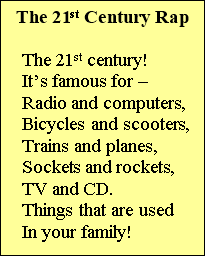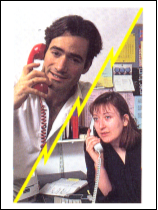Урок "Always Keep in Touch"
Always Keep in Touch
Objectives:
- to improve oral speech skills based on different prompts;
- to develop students’ reading skills;
- to develop students’ listening comprehension skills;
- to develop students’ lexical skills;
- to extend students’ knowledge about the history of inventions;
- to teach students to see reason – consequent relations of the event.
Equipment : pictures, cards, a tape recorder and the cassette, copies of texts.
Procedure:
I. Warm up:
T: Recently I’ve read a very interesting poem. It is the 21st century rap. So, let’s practice some sounds and say what other devices are also used in your homes. Can anybody read this poem in the rap manner?


II.  Defining the main idea.
Defining the main idea.
T: Is there any other invention not mentioned in the poem but often used in our everyday life? Of course, it’s a mobile phone. By the way, nearly one in three adults in the USA say that the cell phone is the invention they most hate but cannot live without. The cell phone even beat the alarm clock and television. So, let’s speak today about cell phones and their impact on our life.
III. Reading comprehension.
T: A cell phone is a thing I personally can’t do without. But do you know when and where was the first mobile phone invented? Insert the given words into the gaps and read the history of its invention.


IV. Group work.
T: A cell phone is an evitable part of our life. But what do you think: is it really worth using or is it more harmful than useful? Let’s see. Split into two groups. The first one will think of merits of using cell phones and the second one will look for its drawbacks. Then we shall name them in turn to see how good or bad this invention really is.
Some possible ideas:
- It improved the quality of life.
- It emits electromagnetic radiation that influences our health.
- There is a great risk of an accident while driving and speaking over the phone.
- Children can get addicted to Internet-linking cell phones.
- A cell phone is a rather expensive toy.
- It affected people’s behaviour.
- It easy to keep in touch with parents and friends.
- Pupils can take pictures for class projects.
- Pupils can text message missed assignments to classmates who are absent.
- We have a calculator handy for both homework and real life.
- We can listen to our favourite music whenever we want.
- Phones contribute towards road traffic accidents.
V. Listening comprehension.
T: Speaking on the phone is a reality of our life. All of us should know how to speak on the phone and how to listen to the speaker. So, listen to the phone conversation and answer the questions in not more than three words.
|
1 |
What is the girl’s name? |
|
|
2 |
Who has phoned to her? |
|
|
3 |
What event has he invited the girl to? |
|
|
4 |
Where will they go? |
|
|
5 |
What time should they meet? |
|


VI. Pair work.
1. Complete the three telephone conversations. Use the phrases from the box. Choose a picture to every of them and explain your choice.







2. Make up your own telephone conversation according to the task:
- invitation to a football match or a concert;
- asking about missed home assignment.
VII. Speaking.
1. Commenting
T: Nowadays there are a lot of different pictures in the Internet. Some of them are rather interesting and even shocking. I have brought the most vivid of them to the classroom. Can you say how do you understand them?





Possible answers:
- It is dangerous to speak on the phone while driving because the absence of the necessary attention can lead to a car crash.
- You should not distract somebody’s attention from the road while driving or crossing street because you may “talk them to death” in the traffic accident.
- A cell phone is very dangerous especially for kids because they can easily get addicted to it and as a result it affects then their behaviour.
- A cell phone is very dangerous for our health because it is a radio device that emits electromagnetic radiation. Radiation can break molecules apart and cause cancer.
- You don’t need your mobile phone when you are at school because the calls can annoy your teachers and friends, interfere with the educational process and draw your attention from the lesson.
-
2. Giving advice.
T: I would like to buy a new cell phone. What phone would you recommend me to buy and why?
Possible answers:
- My phone is Nokia 6300. This model of average class is made in monoblock form factor. Stainless steal gives it style and strength. It is worth noted some technical characteristics such as 2MP camera, FM radio, MP3 player as well as 7.8 MB built memory. If I were you I would buy the phone of this type.
- My phone is Nokia 2760, clamshell. It is multifunctional. It has a colourful display, tiny camera, MP3 player and digital organizer. It allows me to send massages, play games, but it doesn’t have an Internet access. My phone is red, it is more suitable for women. I recommend you to buy such phone as I have.
VIII.  Homework.
Homework.
T: Using of cell phones has changed our lives but the way of using them itself can be also changed soon. Read the text about Mobile-Learning Revolution and discuss the idea using underlined words.
IX. Summing up:
Sources of information:
- English Learner’s Digests
- A textbook “Headway” (elementary). - Oxford University Press, 1993.
- A textbook “Opportunities” (pre-intermediate). - Longman, 2003.
- Internet resources.


про публікацію авторської розробки
Додати розробку
